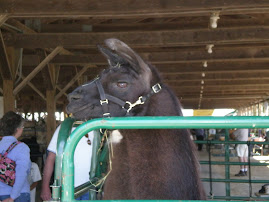When I first learned to spin, back in the early 90's, I read Lee Raven's book
Hands On Spinning, and followed her advice on how to wash fleece. The first fleece I bought was from Reading Terminal Market in Philadephia, a brown fleece from a sheep named Edna. It was only $4 a pound, and extremely dirty, but otherwise a good fleece, probably Romney. I scoured it lock by lock, using Dawn dishwashing soap, 140 degree water, following all the book's instructions. Grab a lock by the cut end, immerse it in the water, scrub the tip end with your other hand, then drop it into a soak bucket. Soak 20 minutes, then drain in a colander and rinse with a bit of vinegar in the rinse water. It was time-consuming to scrub all those tips, but rewarding to transform something once so dirty and smelly into beautiful, clean fiber. It made it very easy to card and fun to spin. Overall, a nice experience.
I then bought a beautiful gray Romney fleece on a trip to the Maryland Sheep & Wool Festival which was not horribly dirty, so I tried washing a couple of pounds of it using a mesh garment bag by
soaking and spinning in a top-loading washing machine (still using Dawn, NO AGITATING). Lots of people use this method, and swear by it. I never felt like it got the fleece clean enough, though. The really dirty part of the fleece (the tips) never got clean, and it is no fun carding and spinning it in this condition. It takes much longer to card. You either have to tease the ends of each lock open with a flicker brush, or if it is really bad, just cut the tips off.
It works OK if the fleece is of a type that is not very greasy, like the Norwegian Spelsau. However, I was so disappointed with the results of washing a Cotswald fleece via this method, that it is still sitting in the mesh bag it was washed in about 5 years ago. It was really greasy and dirty, and it just didn't seem appealing to card or spin without re-washing, and I kind of gave up on it.
The
Ravelry website has a Fiber Preparation forum, with a fleece-washing thread that has been going on for about a year. I started at the beginning of this thread, and read through the whole thing looking for help. It seems that the soaking method is what most people use, but maybe my water was not hot enough, or I wasn't using the right soap, or something. Some people recommend using tulle netting to keep the fleece distributed in a "burrito" formation, so that the water can flow through evenly while soaking. Some people use plastic trays and layer them. Lots of people still use Dawn, but others prefer Kookaburra, Unicorn Power Scour, or Soak.
So, I tried again with a soft, crimpy Merino fleece I had bought at the Maine Fiber Frolic (see photos above). It had looked fairly clean from the outside. But when I got it home, I saw that all the tips were on the inside (as they all are, packaged for judging in the fleece competition) and they were really awful-looking. The label written by the sheep farmer had said "consider professional processing," and I should have. I thought I could handle it. I didn't know that Merino is one of the hardest fleece to process, as it is THE GREASIEST and also felts very easily. So, you have to use very hot water, but be extra-careful not to agitate. I tried using a new soap, Kookaburra Wool Scour, and heating water on the stove to get the temperature up to 160 degrees. I did not have any tulle or plastic trays, so I did not use them. Once again, the fleece got nice & clean, but the tips are still really caked and icky (photo on left is AFTER washing). I finally decided to just cut the tips off (photo on right is after cutting). Once they are cut off, it should be fine. Merino 1, Rebecca zero. But, this isn't over.















